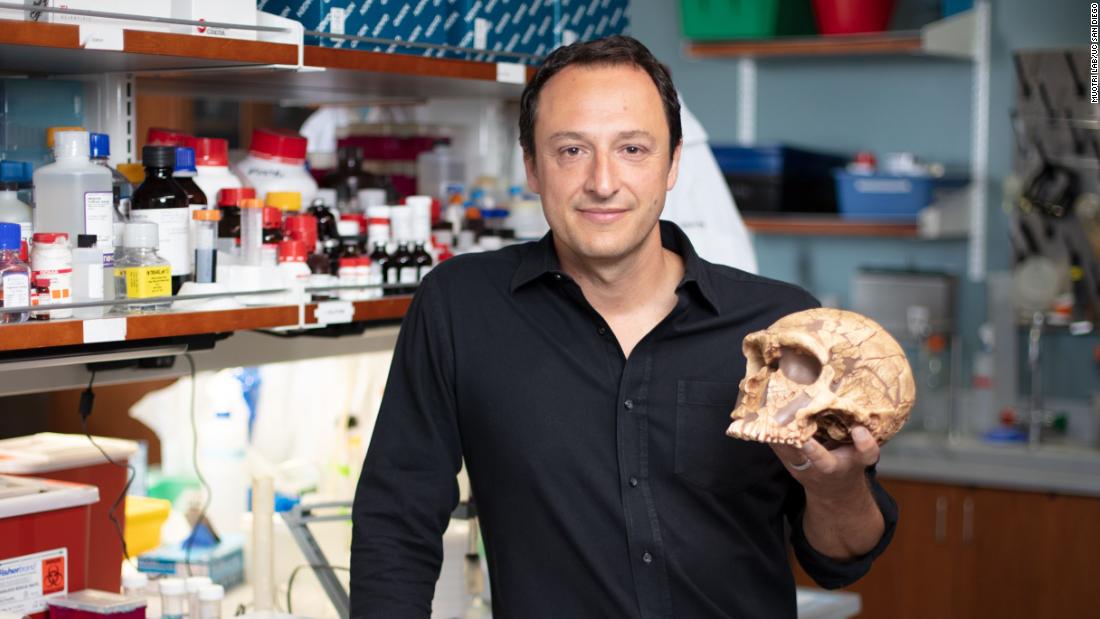From petrified skulls we know that their brains were large – in fact slightly larger than ours – but they tell us little about their neurology and development.
Scientists from the University of California, San Diego, have come up with an exciting and challenging way to begin answering this question. They have created patches of brain tissue that have been genetically modified to carry a gene that belongs to Neanderthals and other archaic hominins, but not to Homo sapiens.
Although the research is at a very early stage, the researchers found that the Neanderthalized brain organoids brought about significant changes in the way the brain was organized and wired.
“The question here is what makes us human,” said Alysson Muotri, professor and director of the stem cell program at the Institute of Genomic Medicine at the University of California.
“Why do our brains differ so much from other species, including our own extinct family members?”
Neuroargeology
Muotri, who has so far spent eight years on the project, calls his work ‘neuro-archeology’.
“If you find a piece of bone or (charcoal) and try to reconstruct how society lived, what they did, how they connected to each other – you try to understand the mind. We do the same with the genetic level.”
The Neanderthalized brain organoids were a ‘popcorn form’ compared to the more rounded, even shape of modern man, Muotri said. His team also noted that the neurons in the organoids age faster than modern humans.
“The neurons in the archaic version of organoids, we see more activity in the very early stages than modern humans. We certainly did not expect that.”
He said he had observed similar activities in his previous work on chimpanzee organoids.
“A chimpanzee can by far outsmart a newborn human. We need time to care for our babies until they become independent. We do not see it in other species. I think it is something similar.”
However, Muotri stressed that it is speculative. Organoids are far from real brains. In the first place, they have no connections with other organs.
“We do not know how the human brain carrying these archaic versions will behave,” he said. “All of these differences we see in the early stages can disappear because the brain has ways to compensate.”
“But we do know that very early, subtle changes in brain development can have consequences for the adult brain. Take, for example, the genes involved in autism.”
Gene editing with archaic material
We now know that many of us are a small part of the Neanderthals, with DNA containing traces of past encounters between the early modern humans and Neanderthals, which were populated in Europe and parts of Asia until about 40,000 years ago.
The UCSD team first compared the genomes of Neanderthals, Denisovans, and modern human populations to determine which genetic variants were not shared with our relatives.
“We asked what’s unique about us? We end up with only 61 protein-coding genes that differ between modern and archaic humans,” Muotri said.
The team chose to focus on a gene known as NOVA1 because it is considered a “master regulator” of other genes that affect early neurodevelopment in modern humans. Changes in this gene have been linked to mental disorders such as schizophrenia and autism, he said.
The scientists then used the CRISPR gene processing technology, which won the Nobel Prize in Chemistry in 2020, to swap the modern NOVA1 gene for the archaic version in human stem cells and attract the stem cells to grow into organoids.
“This is an extremely difficult series of experiments,” said Grayson Camp, an assistant professor at the University of Basel in Switzerland who was not involved in the research.
“Organoids are difficult to control. If they had all the controls there, one would believe that this single amino acid change has a strong effect on brain development. It is extraordinary.”
‘No magical variant that makes us human’
Such audacious research, of course, involves reservations.
Gene processing is not a perfect process, and the insertion of an archaic gene into human cells does not reflect what the Neanderthal genome actually was, said Tony Capra, an associate professor of epidemiology and biostatistics at the Bakar Computational Health Sciences Institute. to the University, said. of California, San Francisco.
“It is challenging to say that the organic results of the Neanderthal variant necessarily reflect how Neanderthal brains evolved,” he said in an email. Capra was not involved in the study.
“This change is being evaluated in the context of human genome, so the archaic variant is on a genetic background that does not reflect what the Neanderthal genome was like.”
Capra was nonetheless excited about the research published in the journal Science on Thursday. However, he warns that ‘we must not expect there to be one magic variant that makes us human.
“Most traits that make us modern humans compared to Neanderthals (or even chimpanzees) are very genetically complex,” Capra said. “Thousands of parts of our genome contribute to neurodevelopment and cognition.”
He added: “Organoids are exciting because they allow us to test variants in more complex settings than single cells, but we will eventually have to ‘neanderthalize’ the organoid.”
Recent archaeological discoveries have suggested that Neanderthals possessed many of the same cognitive abilities as early modern humans, but like the fossils and stone objects, it is unlikely that neuro-archeology will be able to provide definitive answers, Capra said.
“We will never recreate the environmental and social context in which these individuals lived or were able to recreate these events. Environment is so essential to determining how genomes express themselves, that we will always have to speculate,” he said.
That said, I think we will learn a lot more from the bones and genomes in the coming years. “
